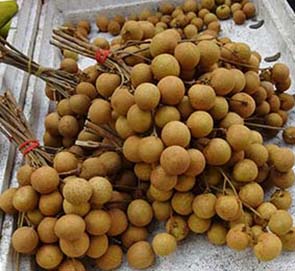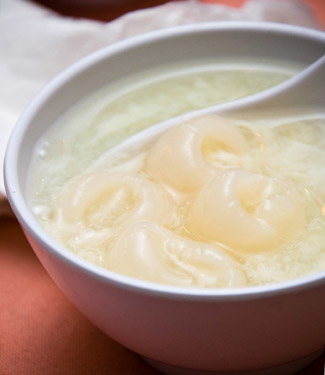Longan (龙眼) Nutrition facts
Longan is a tropical fruiting tree in the Soapberry family (Sapindaceae). Its round, sweet, translucent, juicy berries are one of the favorite fruits in China, Thailand, and the Philippines.
Botanical name: Dimocarpus longan Lour. Other vernacular names for longans include lam-yai (ลำไย), leng-keng (Malaysia and Indonesia), kyet mouk (Myanmar), mien (Cambodia), lam nhai, nam nhai (Laos), and nhãn (Vietnam).
 |
| Longans-as displayed in a market. |
Besides lychee, other closely related fruits under the Sapindaceae (soapberry) family are rambutan (Nephelium lappaceum), lanzones (Lansium domesticum) and pulasan (Nephelium mutabile).
Dimocarpus longan is a tall, spreading, tropical evergreen tree that grows in high-altitude rain forests of Southern China, Myanmar, Thailand, and India. In a season, the tree bears a large number of fruits that are set in panicles.
Longan fruit measures about 1 inch in diameter. It is covered with a tough, leathery shell that turns brown, and fairly rigid when mature. Inside, it encloses white, translucent aril that is a little less aromatic than the lychee. A large, round dark-brown seed is located at the center of the fruit. Seeds are inedible, poisonous, and should be discarded.
8 amazing Health benefits of Longans
Fresh longans carry 109 calories per 100 g of edible portion. It has no saturated fats or cholesterol but is composed of good amounts of dietary fiber, vitamins, and antioxidants.
Fresh arils contain only a few polyphenols antioxidants. However, its skin and seeds contain abundant polyphenols. Quantitative analysis showed that lanzone peel had the highest total flavonoids (213.45 mg quercetin/g dried material) among tropical fruits.
The fruit is very juicy and refreshing. Its simple sugars, fructose, and sucrose, boost energy and help revitalize through electrolytes, minerals, and vitamins.
The juicy arils hold 13% daily requirements of vitamin-C/100 g). Vitamin C is a natural, water-soluble antioxidant. It plays a vital role in tissue repair and as an immune-booster. It helps in the prevention of gum bleeding and iron absorption. Its antioxidant effects help keep the human body disease-free by warding off oxygen-derived free radicals.
The berry carries small amounts of dietary fiber, 0.4 g per 100 g. A good fiber diet helps control cholesterol levels and body weight.
Fresh fruits are very good sources of B-complex vitamins such as thiamin, riboflavin, niacin, and folates. These vitamins are essential since they function by acting as co-factors to help the body metabolize carbohydrates, protein, and fats.
Further, it also carries small amounts of minerals like calcium (2 mg), phosphorus (6 mg) and iron (0.3 mg). Its juicy arils hold small amounts of potassium, an important component of cells and body fluids that help control heart rate and blood pressure.
In Traditional Chinese Medicine (TCM), long yan (龍眼肉) is considered as yin food that purifies blood and enhances heart and spleen functions. It is indicated to calm the mood and to treat insomnia, palpitations, forgetfulness, and dizziness problems associated with stress or overwork.
| Principle | Nutrient Value |
|---|---|
| Energy | 109 kcal |
| Carbohydrates | 25.2 g |
| Protein | 1 g |
| Cholesterol | 0 mg |
| Dietary Fiber | 0.4 g |
| Vitamins | |
| Vitamin C | 8 mg | Niacin | 0.6 mg |
| Riboflavin | 0.07 mg |
| Thiamin | 0.04 mg |
| Vitamin-A | 28 IU |
| Minerals | |
| Calcium | 2 mg |
| Iron | 0.3 mg |
| Phosphorus | 6 mg |
Selection and storage
Longan fruits can be ready for harvesting by July end and August first week. In the markets, choose round brown longans with intact surfaces. Ripe berries just yield to thumb pressure. Avoid small, unripe, or dysmorphic berries, and those showing cracks, dried, and shriveled as they tend to be less flavorful.
At home, eat longans as early as possible. Otherwise, place them in a cool, well-ventilated place for 3-5 days. Store in the fridge for 1-2 weeks in a paper pack to avoid moisture build-up. Peeled/seeded fruits, however, perish early and should be consumed early.
Preparation and serving methods
Longans can be used in the same way as lychee and lanzones. To prepare, just wash the fruit in cold water and mop dry using a clean towel. Peel the outer cover by splitting it near the stem end and then working downwards. You can either pit the fruit, or put it in the mouth, gently squeeze out (separating) the pit from the flesh between tongue and teeth, and spit out the seed (pit) after sucking juice and aril.
Just like other soapberry family fruits like lychee, ripe longans are generally eaten raw out of hand. Enjoy their sweet and musky arils and spit-out seeds.
 |
| Longan egg-white souffle dessert. Photo courtesy: Chee.hong. |
Here are some serving tips:
Longans are one of the popular table fruits in Southeast Asian households. Just enjoy them without any add on/seasonings.
They can be used in salads, additions in ice creams, sorbets, and shakes.
Whole, or pitted berries can be added to fruit salads with other complementing summer treats like mango, lychee, rambutan, snake fruit, etc.
Longan eggwhite whisked souffle is a popular dessert in Vietnam.
Dried longans are used in Chinese herbal medicine as a relaxing infusion.
Safety profile
Unripe, raw fruits contain astringent compounds like tannins, which may burn the oral cavity, tongue, palates, and throat. Discard longans seeds.
Pregnant women can enjoy longans in limited quantities, but avoid chewing the seeds.
Research studies suggest that eating too many soapberry family fruits like longan, lychee, akhee, and rambutan may result in hypoglycemia (low blood sugar levels), especially in undernourished children. The symptoms of hypoglycemic encephalopathy may include headache, thirst, sweating, vomiting, lethargy, seizures, coma, and death over a span of hours to days. (Reference: Spencer PS, Palmer VS, Mazumder R. Probable Toxic Cause for Suspected Lychee-Linked Viral Encephalitis. Emerg Infect Dis. 2015;21(5):904-905). (Medical disclaimer).
Also read ≻≻-
≻≻-Lanzone (Langsat) fruit nutrition facts and health benefits.
≻≻-Rambutan nutrition facts and health benefits.
≻≻-Lychee (litchi) nutrition facts and health benefits.
≻≻-Back to Fruits from Longans. Visit here for an impressive list of all variety of fruits with complete illustrations of their nutrition facts and health benefits.
≻≻-Back to Home page.
Further References:
Fruits of Vietnam. (opens new window)
Production guide.- PDF.